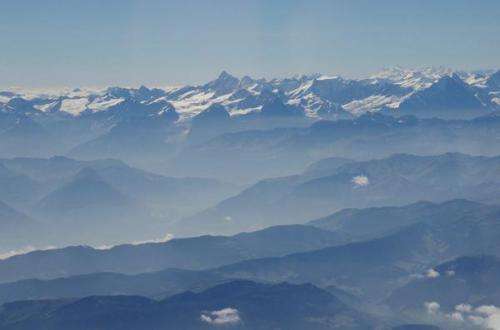Soot suspect in puzzling mid-1800s Alps glacier retreat

Scientists have uncovered strong evidence that soot, or black carbon, sent into the air by a rapidly industrializing Europe, likely caused the abrupt retreat of mountain glaciers in the European Alps.
The research, published Sept. 2 in the Proceedings of the National Academy of Sciences, may help resolve a longstanding scientific debate about why the Alps glaciers retreated beginning in the 1860s, decades before global temperatures started rising again.
Thomas Painter, a snow and ice scientist at NASA's Jet Propulsion Laboratory in Pasadena, Calif., is lead author of the study, and co-authors include Waleed Abdalati, Director of the Cooperative Institute for Research in Environmental Sciences (CIRES) at the University of Colorado Boulder.
Glacier records in the central European Alps dating back to the 1500s show that between 1860 and 1930, loosely defined as the end of the Little Ice Age in Europe, large valley glaciers in the Alps abruptly retreated by an average of nearly 0.6 mile (1 kilometer). Yet weather in Europe cooled by nearly 1.8 degrees Fahrenheit (1 degree Celsius) during that time. Glaciologists and climatologists have struggled to understand the mismatch between the climate and glacier records.
"Something was missing from the equation," Painter said.
To investigate, he and his colleagues turned to history. In the decades following the 1850s, Europe was undergoing a powerful economic and atmospheric transformation spurred by industrialization. Residents, transportation, and perhaps most importantly, industry in Western Europe began burning coal in earnest, spewing huge quantities of black carbon and other dark particles into the atmosphere.
When black carbon particles settle on snow, they darken the surface. This melts the snow and exposes the underlying glacier ice to sunlight and relatively warm air earlier in the year, allowing more and faster melt.
To determine how much black carbon was in the atmosphere and the snow when the Alps glaciers began to retreat, the researchers studied ice cores drilled from high up on several European mountain glaciers. By measuring the levels of carbon particles trapped in the ice core layers and taking into consideration modern observations of the distribution of pollutants in the Alps, they could estimate how much black carbon was deposited on glacial surfaces at lower elevations, where levels of black carbon tend to be highest.
The team then ran computer models of glacier behavior, starting with recorded weather conditions and adding the impact of lower-elevation black carbon. By including this impact, the simulated glacier mass loss and timing finally were consistent with the historic record of glacial retreat, despite the cool temperatures of the time.
"This study uncovers some likely human fingerprints on our changing environment," Abdalati said. "It's a reminder that the actions we take have far-reaching impacts on the environment in which we live."
"We must now look closer at other regions on Earth, such as the Himalaya, to study the present-day impacts of black carbon on glaciers," said Georg Kaser, a study co-author from the University of Innsbruck and lead author of the Working Group I Cryosphere chapter of the Intergovernmental Panel on Climate Change's upcoming Fifth Assessment Report.
More information: End of the Little Ice Age in the Alps forced by industrial black carbon, www.pnas.org/cgi/doi/10.1073/pnas.1302570110
Journal information: Proceedings of the National Academy of Sciences
Provided by University of Colorado at Boulder


















